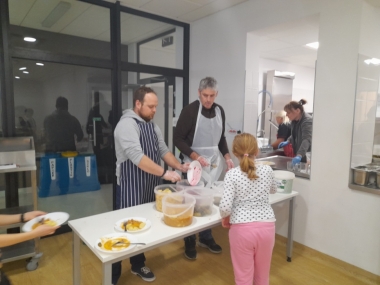MICRO GOOD PRACTICES in action! Measuring uneaten food in one of Wrocław's Schools
Edited on
23 June 2022Wasting food is one of the biggest problems in the world today. Food losses are mostly a problem of developing countries - lack of knowledge about food storage, and lack of infrastructure cause spoilage of huge amounts of food. Every day, food is wasted at every stage of the supply chain, from production, through transport and storage, to consumption itself.

Wasting at the consumption stage concerns not only individual households but also catering or educational institutions, where meals for several hundred children are prepared every day. To be able to make the right decisions on what and how to do to prevent waste one must know what, how much and why is thrown away. The Department of Water and Energy, together with the University of Life Sciences - Department of Applied Bioeconomics and Venturis HoReCa company, within the BioCanteens#2 project, conducted quantitative analyses and structure of discarded food waste divided into four fractions in the School and Kindergarten Complex No. 21 at 40 Kłodzka Street. In April, for five days the team weighed how much food was not eaten by children during their lunch break, but also how much food is wasted in the kitchen during meal preparation itself.
The study was conducted in two 5-day parts. During the first measurement in April, the scale of overproduction was determined, i.e. the part of lunches that is prepared but for various reasons not eaten by children. The difference between what was prepared in the menu structure and what was not eaten (both as leftovers on plates and food that is left in the kitchen unspent) showed us how much and what is actually eaten by the children.
The findings were used in a second measurement in May, when the same 5-day menu was repeated. The key issue was to reduce the production volume and match it to what and how much the children ate in April. In addition to quantitative analyses, qualitative analyses were conducted including workflow, warehouse management, menu management, and purchasing. Part of the project was also to collect the opinions of parents, children and teachers about the quality of food and their ideas to make the food prepared at school No. 21 even better. It turned out that school No.21 is doing very well in terms of work organisation, warehouse management and purchasing of raw materials. The research also showed the scale of overproduction.During a measurement in May, when quantities were matched to the actual needs of the children, it was found that school reduced food waste by 500 kg. The improvement of the quantitative result translated into financial savings - within 5 days 7 500 PLN ( approximatively 1.600 euros) less was spent on the purchase of raw materials compared to April.
This is only the beginning of qualitative and quantitative changes in the management of meals at school. The biggest challenge at the moment is to maintain the positive trend of reducing food waste and revamping the menu to take into account some of the requests from children and parents. The key will be the connection and synergy between actions related to qualitative changes in nutrition and quantitative issues, i.e. rationalization of the volume and structure of production. In times of rising food prices and high pressure to increase prices for lunches in educational institutions, it seems necessary to limit the scale of waste and uneaten overproduction. It means savings amounting to hundreds of thousands of zlotys throughout the year.
Submitted by Clara Garrone on
